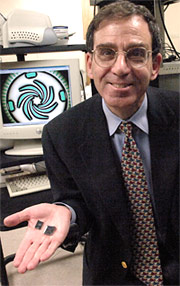Engine on a chip promises to best the battery
MIT researchers are putting a tiny gas-turbine engine inside a silicon chip about the size of a quarter. The resulting device could run 10 times longer than a battery of the same weight can, powering laptops, cell phones, radios, and other electronic devices.
It could also dramatically lighten the load for people who can't connect to a power grid, including soldiers who now must carry many pounds of batteries for a three-day mission—all at a reasonable price.
The researchers say that in the long term, mass production could bring the per-unit cost of power from microengines close to that of power from today's large gas-turbine power plants.
Making things tiny is all the rage. The field—called microelectromechanical systems, or MEMS—grew out of the computer industry's stunning success in developing and using micro technologies. “Forty years ago, a computer filled up a whole building," said Professor Alan Epstein of the Department of Aeronautics and Astronautics. “Now we all have microcomputers on our desks and inside our thermostats and our watches."
While others are making miniature devices ranging from biological sensors to chemical processors, Epstein and a team of 20 faculty, staff, and students are looking to make power—personal power. “Big gas-turbine engines can power a city, but a little one could ‘power' a person," said Epstein, whose colleagues are spread among MIT's Gas Turbine Laboratory, Microsystems Technology Laboratories, and Laboratory for Electromagnetic and Electronic Systems.


